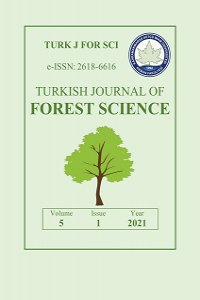ORMANCILIKTAKİ SPROUT TERİMİNİN TÜRKÇE KARŞILIĞI İÇİN BİR ÖNERİ
Sprout, İngilizcede shoot (sürgün) terimi ile yakın ilişkili bir terimdir. Sprout terimi, esas itibariyle, bir odunsu bitkinin dibi, kütüğü, kök boğazı veya kökünden çıkan sürgünler için kullanılmaktadır. Bu sürgünler, bitkilerde çoğu kez çeşitli sebeplerle oluşan zararları takiben ortaya çıkmakta ve ağaçlar içerisinde genellikle geniş yapraklı ağaçlarda görülmektedir. Sprout kavramı içerisinde yer alan sürgünler, sahip oldukları çeşitli nitelikler ile ağaçlardaki uç ya da yan sürgünlerden belirgin bir şekilde ayrılırlar. Sprout teriminin Türkçede henüz tam bir karşılığı bulunmamaktadır. Türkçenin kelime hazinesinde var olan fışkın kelimesinin, sprout teriminin gayet uygun bir karşılığı olduğu görülmektedir. Ormancılıkta, özellikle silvikültür, şehir ormancılığı ve orman botaniği ile ilgili konularda kullanılan sprout terimi için fışkın karşılığının kabulü ve kullanılması tarafımızdan önerilmektedir.
Anahtar Kelimeler:
Sürgün, fışkın, terim, ormancılık, silvikültür
A SUGGESTION FOR THE TURKISH EQUIVALENT OF THE TERM SPROUT IN FORESTRY
Sprout is a term that is closely related to the term shoot in English. The term sprout is mainly used for the shoots arising from the base, stump, root collar or root of a woody plant. These shoots often occur following the damages taking place due to various reasons in plants and are generally seen in broadleaved trees within trees. The shoots within the concept of sprout are distinctly separated from the terminal or lateral shoots in the trees by the various features they have. The term sprout has yet no exact equivalent in Turkish. The word fışkın that exists in the vocabulary of Turkish is seen to be a very appropriate equivalent of the term sprout. It has been suggested by us to adopt and use the fışkın equivalent for the term sprout, which is used in forestry, especially on the subjects related to silviculture, urban forestry and forest botany.
___
- Akdikmen, R. (1994). Langenscheidt büyük sözlük, İngilizce-Türkçe. Ders Kitapları A.Ş., İstanbul.
- Atalay, H. (1999). İngilizce-Türkçe sözlük, 2 J-Z. Atatürk Kültür, Dil ve Tarih Yüksek Kurumu Türk Dil Kurumu, Yayın No: 714, Ankara.
- Avşar, M. D. (2018). Şehir ağaçlarında kök sürgünü problemi ve bazı öneriler. Turkish Journal of Forest Science, 2(1), 91-97.
- Çelik, H. (2017). Bağlarda taç yönetimi-yaz budamaları. TÜRKTOB Türkiye Tohumcular Birliği Dergisi, 6(22), 36-45.
- Daniel, T. W., Helms, J. A., & Baker, F. S. (1979). Principles of silviculture (2nd ed.). McGraw-Hill, Inc., New York, NY.
- Doğan, D. M. (1992). Büyük Türkçe sözlük (9. baskı). Rehber Yayınları, Yayın No: 8, Ankara.
- Eler, Ü. (1991). İngilizce-Türkçe ormancılık sözcük ve deyimleri. T.C. Orman Bakanlığı Orman Genel Müdürlüğü, Ankara.
- Eren, H., Gözaydın, N., Parlatır, İ., Tekin, T., & Zülfikar, H. (1988). Türkçe sözlük, 1 A-J. Atatürk Kültür, Dil ve Tarih Yüksek Kurumu Türk Dil Kurumu, Yayın No: 549, Ankara.
- Eren, H. (1999). Türk dilinin etimolojik sözlüğü (2. baskı). Ankara.
- Evans, J. (1984). Silviculture of broadleaved woodland. Forestry Commission Bulletin 62, London.
- Fowells, H. A. (1965). Silvics of forest trees of the United States. U.S. Department of Agriculture Forest Service, Agriculture Handbook No. 271, Washington, DC.
- Gezer, A. (1991). Açıklamalı ormancılık terimleri sözlüğü, Türkçe-İngilizce ve İngilizce-Türkçe. Ankara.
- Hawley, R. C. (1921). The practice of silviculture, With particular reference to its application in the United States. John Wiley & Sons, Inc., New York, NY.
- Helms, J. A. (Ed.) (1998). The dictionary of forestry. The Society of American Foresters, Bethesda, MD.
- Huxley, P., & van Houten, H. (1997). Glossary for agroforestry. International Centre for Research in Agroforestry, Nairobi.
- Koelling, M. R., Heiligmann, R. B., Peterson, G., & Potter-Witter, K. (2006). Forest resource management terminology. Michigan State University Extension, NCR-478, East Lansing, MI.
- Matthews, J. D. (1997). Silvicultural systems. Clarendon Press, Oxford.
- Pinchot, G. (1905). Terms used in forestry and logging. U.S. Department of Agriculture Bureau of Forestry, Bulletin No. 61, Washington, DC.
- Salazar Parra, A. A. (2010). Seed dynamics and seedling establishment of woody species in the tropical savannas of central Brazil (cerrado). PhD Dissertation, University of Miami, Coral Gables, FL.
- Sıvacıoğlu, A. (2001). Bartın orman işletmesi meşe (Quercus sp. L.) ve kayın (Fagus orientalis Lipsky) baltalıklarında koruya dönüştürme olanakları üzerine araştırmalar. Doktora Tezi, Zonguldak Karaelmas Üniversitesi Fen Bilimleri Enstitüsü, Bartın.
- Smith, D. M., Larson, B. C., Kelty, M. J., & Ashton, P. M. S. (1997). The practice of silviculture: Applied forest ecology (9th ed.). John Wiley & Sons, Inc., New York, NY.
- Society of American Foresters. (1917). Forest terminology. Journal of Forestry, 15, 68-101.
- Toparlı, R. (2000). Ahmet Vefik Paşa, Lehce-i Osmânî. Atatürk Kültür, Dil ve Tarih Yüksek Kurumu Türk Dil Kurumu, Yayın No: 743, Ankara.
- Tuğlacı, P. (1985). Okyanus ansiklopedik sözlük (8. baskı). Cilt 3, Cem Yayınevi, İstanbul.
- Yılmaz, M. (2010). Is there a future for the isolated oriental beech (Fagus orientalis Lipsky) forests in southern Turkey?. Acta Silvatica & Lignaria Hungarica, 6, 111-114.
- Yayın Aralığı: Yılda 2 Sayı
- Başlangıç: 2017
- Yayıncı: Kahramanmaraş Sütçü İmam Üniversitesi
